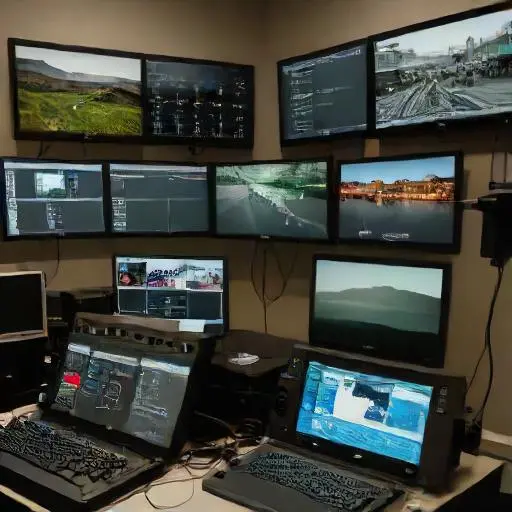Guide
How to Film a Movie: The Ultimate Guide for Beginners in 2024

- Planning is crucial – develop a solid script, storyboards, and shot list blueprint
- Assemble a talented cast and crew of filmmakers
- Scout unique locations and secure proper permits
- Master cinematography fundamentals like lighting, camera angles, and audio
- Edit footage into a compelling final cut
- Promote and distribute your completed movie
Introduction
Have you ever dreamed of making your own movie? Whether you want to film an indie masterpiece or just have fun with friends, this ultimate guide covers everything beginners need to know about how to film a movie in 2024. We’ll walk through every step from initial concept to wrapped production and distribution.

Developing Your Film’s Concept
The first step in how to make a movie is conceptualizing your story and vision. This critical pre-production phase includes:
Writing the Script
All great movies start with an engaging script that lays out the plot, characters, dialogue, and scenes. Spend plenty of time iterating and polishing your script until it’s perfect.

Creating Storyboards
Once the script is locked, map out a visual blueprint by storyboarding each planned shot, camera angle, movement, and more. Detailed storyboards are every director’s handbook.
Building a Shot List
After storyboarding, organize every single camera setup into a shot list that will maximize efficiency during the actual filming.
Assembling Your Cast and Crew
No movie can be a one-person show. You’ll need to assemble a skilled team of cast and crew members including:
- Producers to oversee logistics
- A director to lead the creative vision
- Cinematographers and camera operators
- Lighting team (gaffers, grips)
- Production design for sets, props, wardrobe
Image 3: Behind-the-scenes photo of a movie director giving instructions to the crew
Securing Filming Locations and Permits
Proper location scouting is a must for capturing great footage. Scout unique, visually interesting places that fit your story whether urban, rural, studio sets, or practical locations. Just be sure to secure any required permits, insurance, and homeowner permissions first.
Camera, Lights, Audio – The Filming Essentials
Mastering Cinematography Basics
To capture cinematic footage, beginner filmmakers need to understand core cinematography techniques like:
- Camera operation and lens choices
- Framing, composition and camera angles
- Camera movement techniques
- Depth of field and focus pulls

Lighting Like a Professional
Lighting makes or breaks your final footage quality. Skilled gaffers, grips, and cinematographers use key lights, fill lights, practical lights, gels, diffusion and more to create dynamic, flattering illumination.
Capturing Quality Audio
Audio is just as vital as the visuals. Always invest in quality external mics, booms, and digital recorders rather than just using the camera’s built-in mic.
Editing Your Footage into a Final Product
With all your shots in the can, now it’s time to shape that raw footage into a polished, cinematic final product through the editing process:
- Building an engaging pacing and rhythm
- Choosing impactful shots and trimming fat
- Cutting for continuity between scenes
- Adding visual effects, graphics, and color grading
- Editing sound effects, music scoring and mixing

Film Distribution and Marketing
The work isn’t over once your film is “picture locked!” Now you need a strategy for promoting your indie gem and getting eyeballs through:
- Submitting to film festivals and competitions
- Seeking distribution deals with streaming, TV, etc.
- Grassroots self-promotion on social media
With enough hustle and perseverance, your movie could gain a loyal cult following or possibly even go mainstream!
More Tips for Beginning Filmmakers
Invest in Affordable Gear: You don’t need expensive Hollywood equipment to start filming quality movies. Modern DSLRs, affordable LED lighting kits, and editing programs like DaVinci Resolve can produce amazing results.
Formal Training Helps: While not mandatory, considering enrolling in a film school program or taking courses can rapidly accelerate your skills.
Watch and Study Great Films: One of the best ways to learn is closely studying lighting, cinematography, pacing, and editing in classic and contemporary movies.
Stay Determined: Filmmaking is an incredibly rewarding but challenging endeavor. Stick with it, keep learning and practicing, and your skills and opportunities will grow!
With commitment, creativity, and this guide’s production tips, you’ll be ready to write, film, edit and market your very first movie! Let the cameras start rolling.

Guide
Make a Budget: A Step-by-Step Guide to a Budget

Introduction
It’s pretty important, more so in the fast-moving modern world, really, to take care of your own personal finance in order to be stable and channel towards long-term goals. Some basic money management involves knowing how to create a budget. At its core, a budget has always been about establishing a tracking system for both income and expenses while, at the same time, saving for the future and living within the parameters to develop a healthier financial base.
This ultimate guide will impart to you how to make a budget, step by step, by offering expert tips and actionable advice so that you can have full control over your finances. Whether you are a novice in budgeting or want to brush up on your budgeting skills, it will work for you.
Going through the process illustrated by this how-to will give you a way to make a budget that fits your lifestyle, meets your financial objectives, and is set up for success in the long run. From the determination of income and expenses to the financial goals you will be working toward and monitoring progress, all in this step-by-step guide, take your time to go through. OK, let’s dive into the process.
Explanation: The Lifeline of Budgeting
Before proceeding with the detailed, step-by-step process of how to make a budget, there is the need to recognize why budgeting should be done. Through budgeting, one will, therefore, be in control of appropriations over finances and have informed decisions over money matters, avoid going into debt, and plan for future needs.

THE ADVANTAGES OF BUDGET
Budgeting is a potent financial instrument that provides a number of key advantages:
- Money Awareness: A budget allows you to be aware of where your money is going and helps you consciously make decisions on how you plan to spend and save your money.
- Debt Reduction: Knowing where your expenses go would let you divert a little more into a debt pay-out and, hopefully, keep you from falling into future financial ditches.
- Reach your goals: Be it to save up for a new car, the down payment toward owning your home, or even an emergency fund, your budget sets available sources of funds aside to reach your goals.
- Peace of Mind: It helps you to be secure because one will have a prepared mind for any most surprising event that might strike them financially.

Common Budget Blunders
Although budgeting is important, there are several pitfalls into which many people fall:
- Unrealistic Goals: In my opinion, when one sets unrealistic goals in respect to financial happiness, it only leads to frustration and tends to get people throwing their budgets to the wind.
- Ignoring small expenses: Daily coffees or streaming costs can easily creep up, then suddenly your budget goes to hell.
- Being Rigid: If a budget is set, it should be flexible. Rarely do things go by the plan, and some unexpected expenses will pop up. Therefore, such expenses should call for changes in your budget.

2. Creating a Budget: Step-by-Step
Let’s go through the step-by-step guide on how to develop a proper budget for yourself. Follow through with these hands-on steps in building a budget that will work for your financial success.
Step 1: Assess Your Income
The first step in money-tracking is to identify how much total monthly income you have from your salary, bonuses, side hustles, and all other forms of income. Be sure it’s your net income, that is, the money you have in your pocket after all possible deductions, like tax, have been made, because this is the money that you hold and can transact with.
Illustration: For example, if you were making $3,500 in a month in a normal job environment but you made another $500 in a month with your kind of hustle, then your net income would be $4,000 in a month.

Step 2: List Your Expenses
Step two is listing all of what you spend monthly. You can go ahead to categorize these into fixed costs and variable costs. There are those that do not change during the end or beginning of the month—these are termed as fixed expenses. They may include rent/mortgage, car payments, insurance, and utilities. There are those that depend on the daily or weekly event of the month—these are termed as the variable expenses. They include groceries, entertainment, and transportation.
Examples of this are: Fixed costs can be $1,500 for rent, insurance, and utilities. Variable costs can be another $1,000. This would include groceries, restaurants, and gas.

Step 3: Expense Sorting
Third, categorize your expenses into needs or wants. Needs are those of great importance, like housing, food, and transportation, whereas wants are things that possibly are not that necessary: dining out, streaming services, or going to a movie.
Example: Groceries are a need, whereas dining out is a want.
Step 4: Set Financial Goals
Having done that, now it’s time to set financial goals. These can be short-term, like a vacation or paying down debt, to long-term, such as saving. Just make sure your goals are SMART: Specific, Measurable, Achievable, Relevant, Time-bound.
Example: Save $2,000 in an emergency fund within the next six months.
Step 5: Monitoring and Adjusting Spending
When you have a budget in place, further ensure you are not overspending by keeping track of your spending. Many people use apps or budgeting spreadsheets to keep track of what they spend. Review spending regularly and adjust when suitable.
Example: If you have realized that you are spending too much money eating out, cut back in such areas and divert that money into your savings.

Step 6: Review and Adjust Budget
A budget is not a static document but is reviewed and updated from time to time. Life is dynamic, and your budgets need to reflect this. For example, if there are any changes in income, new financial goals, or unexpected expenses, it’s important that your budget reflects the new state of affairs.
For example: If your salary gets increased, then update your budget for this new highest level of income and maybe adjust your savings contributions accordingly.

3. How to Make Sure You Stick to Your Budget
When you’ve learned how to budget, there are some vital measures you apply that help you to stick with it. Below are some of them:
- Make Savings Automatic: You can schedule automatic transfers in the account every month to your savings, which helps in saving without realizing and ensures a faster reach of your financial goals.
- Put Budgeting Tools and Apps to Use: There are so many budgeting tools and apps out there, which can make tracking your spending a little less painful. Among the more popular are Mint, YNAB, and EveryDollar.
- Plan for Unexpected Expenses: You never know about life, and even the best budget can be thrown off by unexpected expenses. Be sure to allocate from your income for an emergency fund to cover costs you weren’t expecting.
Example: You may want to put 10% of your income to the side for those things that come up all of a sudden, such as your car breaking down or medical bills.

4. Challenges in Budgeting and How to Overcome Them
Budgeting is easy in theory but difficult in execution. Some of the most common budgeting struggles are as follows, along with how you can overcome them:
- Impulse Spending: That may be a quick budget-busting item with impulsive buying, especially if the purchases are not a necessity. To be ready for this, institute a waiting period on big buys and ask if it will work for your budget.
- Challenge 2: Lack of Motivation: Keeping oneself motivated toward budgeting might challenge, especially when some long-term goals are at stake. Divide your target into smaller and achievable milestones in order to keep yourself always motivated.
- Challenge 3: Not Adjusting for Life Changes: Life changes, such as job change, moving, or the addition of family members, can affect your budget. Be sure and revisit and reassess your budget to account for your life changes.

5. Frequently Asked Questions About Budget
Here are some of the typical questions on how to make a budget: step by step:
- How often should I review my budget? You will find it a great idea to at least go through your budget once a month to easily identify your progress and probably make some changes.
- What if my income is less than expenses? In case your expenses are larger than your income, then such expenses should be cut down. The first to be considered are the discretionary expenses, which are sought to do away with fixed costs where possible.
- Should I be spending cash or credit when following a budget? You can keep your budget because it is easy to track physical money flowing in and out when you use it for discretionary spending. And it is quite good to use a credit card with its built-in budgeting tools if you pay your balance every month without falling into debt.
- What do I need to think about for having a plan for saving? A good rule of thumb is 20 percent of one’s income to be set aside for savings that include retirement or emergency. Exact percentage will vary depending on your financial goals.
Conclusion
In creating your budget, take the first step to taking control of your finances, leading to financial independence. This step-by-step guide to creating your budget offers you a comprehensive set of tools and practical knowledge that will enable you to lay down a sound financial stage. Remember to assess your income, categorize your expenses, set financial goals, and regularly review your budget to stay on track. Consistency and discipline are what allow an individual to meet their financial goals and sleep better at night.
Guide
Which Countries Has the Most Movies? Rankings Revealed
The United States, India, and China lead the pack in producing the highest number of movies annually, with Hollywood, Bollywood, and a burgeoning Chinese film industry dominating the global market.

The global movie industry has long been dominated by a select few powerhouses, with the United States, India, and China leading the pack in producing the highest number of movies annually. From the iconic Hollywood film industry to the vibrant Bollywood scene and the burgeoning Chinese cinematic landscape, these nations have cemented their status as the top movie-producing countries in the world.
This comprehensive article explores the countries that have the most movie output, delving into the factors that contribute to their cinematic dominance, the cultural significance of movies, and the future trends shaping the global filmmaking landscape. By examining the latest data and industry insights, we unveil the rankings that reveal which nations are leading the charge in the world of movie production.
Whether you’re a cinephile, a budding filmmaker, or simply someone fascinated by the global dynamics of the movie industry, this article promises to take you on an engaging journey through the diverse and ever-evolving world of cinema. Prepare to be captivated by the stories, the statistics, and the insights that shed light on the countries that have the most movies.
Key Takeaways
- The United States, India, and China are the top three movie-producing countries globally.
- Hollywood, Bollywood, and China’s film industry are the dominant players in the global movie landscape.
- Factors such as government support, available resources, and talent pools contribute to a country’s cinematic dominance.
- The rise of streaming platforms has disrupted traditional movie distribution models and increased global access to diverse content.
- Emerging trends like independent and low-budget productions, as well as technological advancements, are shaping the future of filmmaking worldwide.
Introduction to the World of Movies
The global movie industry has experienced exponential growth, with countries worldwide vying to establish themselves as major players in the world of film production. This section delves into the far-reaching impact of cinema on society and the captivating allure of the art of moviemaking.
The Global Impact of Cinema
Movies have long been a powerful medium, transcending cultural boundaries and captivating audiences around the globe. The global movie industry has evolved into a dynamic and influential force, shaping cultural narratives and leaving an indelible mark on societies worldwide. From Hollywood’s blockbusters to the vibrant Bollywood scene, the cinematic landscape continues to reflect and influence the zeitgeist of our times.
The Fascination with Movie Production
The process of movie production has long been a source of fascination for audiences and aspiring filmmakers alike. The intricate behind-the-scenes workings of the industry, the artistry of storytelling, and the technical mastery required to bring a vision to life on the silver screen have captivated the imaginations of people worldwide. As the cultural impact of cinema continues to grow, the allure of the movie-making industry shows no signs of waning, with countries vying to establish themselves as hubs of cinematic excellence.
Methodology: Counting the Movies
Determining the countries with the highest movie output requires a well-defined methodology. This section outlines the criteria used to include movies in the analysis, as well as the data sources and analysis techniques employed to gather and interpret the relevant information on movie production data, movie industry statistics, and data analysis methods.
Defining the Criteria for Movie Inclusion
To ensure a comprehensive and accurate analysis, the study established a set of criteria for including movies in the data set. This included factors such as minimum runtime, release format (theatrical, direct-to-video, or streaming), and production status (completed vs. abandoned). By defining these parameters, the research team was able to accurately capture the movie output of each country while maintaining consistency across the data.
Data Sources and Analysis Techniques
The data for this study was sourced from a variety of reputable industry databases and government publications, including the International Movie Database (IMDb), national film boards, and industry reports. These data sources provided detailed information on movie production, release, and performance statistics, allowing the research team to conduct a thorough analysis of the movie industry statistics and data analysis methods employed by various countries.
The data was then carefully curated and analyzed using advanced data analysis techniques, such as statistical modeling, trend analysis, and cross-country comparisons. This rigorous approach ensured that the findings accurately reflected the nuances and trends within the global movie production landscape.
Top Countries with the Highest Movie Output
The global movie industry is a captivating landscape, with certain nations emerging as powerhouses in movie production. Two standout contenders in this realm are the United States and India, each commanding a significant presence on the world stage.
United States: Hollywood’s Dominance
The United States, with its iconic Hollywood film industry, has long reigned supreme in the global movie landscape. Hollywood, the epicenter of American cinematic excellence, boasts an unparalleled track record of producing a vast array of high-quality films that have captivated audiences worldwide. From big-budget blockbusters to critically acclaimed dramas, the United States has consistently demonstrated its ability to churn out an impressive number of movies each year, solidifying its position as a top movie producing country.
The sheer scale and resources of the Hollywood film industry, combined with its rich talent pool, state-of-the-art production facilities, and well-established distribution networks, have all contributed to the United States’ cinematic dominance. Hollywood’s global reach and influence have transcended borders, making American movies a staple in movie theaters and living rooms around the world.
India: Bollywood’s Prolific Filmmaking
Alongside the United States, India has emerged as another powerhouse in the global movie production landscape, with its vibrant Bollywood industry. Bollywood, the epicenter of Indian cinema, is renowned for its prolific output, churning out hundreds of movies annually. This thriving film industry has captivated audiences both within India and globally, with its distinctive blend of song, dance, and compelling storytelling.
The cultural significance and widespread appeal of Bollywood movies have been instrumental in cementing India’s status as a top movie producing country. The industry’s ability to cater to diverse tastes, adapt to changing trends, and leverage its vast domestic market have all contributed to its sustained dominance in the global movie landscape.
| Country | Annual Movie Output | Key Industry Attributes |
|---|---|---|
| United States | 700-800 movies | Hollywood’s global reach, vast resources, and talent pool |
| India | 1,500-2,000 movies | Bollywood’s prolific output, cultural resonance, and domestic market strength |
Emerging Film Industries Around the Globe
While the United States and India have long been the titans of the movie world, other nations are now making significant strides in establishing their own thriving film industries. This section highlights the rise of China’s cinematic influence and the remarkable growth of Nigeria’s Nollywood, showcasing the diversification and globalization of the movie landscape.
China’s Growing Cinematic Influence
The Chinese film industry, often referred to as the Chinese film industry, has been steadily gaining global prominence in recent years. Fueled by a rapidly growing domestic market, substantial government support, and a surge in local talent, China’s cinematic influence is steadily expanding beyond its borders. The country’s investment in state-of-the-art production facilities, the emergence of acclaimed directors, and the increasing international recognition of Chinese films have all contributed to its rising status as a major player in the emerging movie industries.
Nigeria’s Nollywood: A Force to Reckon With
Nollywood, the Nigerian film industry, has emerged as a remarkable Nollywood cinema success story. With its prolific output, innovative storytelling, and dedication to showcasing the diverse cultural fabric of the African continent, Nollywood has captured the attention of global audiences. This emerging movie industry has not only transformed the cinematic landscape within Nigeria but has also gained widespread recognition for its ability to produce high-quality, locally-relevant content that resonates with viewers around the world.
| Key Factors Driving the Growth of Emerging Film Industries | China’s Film Industry | Nigeria’s Nollywood |
|---|---|---|
| Government Support and Incentives | Substantial government investment and policy initiatives to promote the Chinese film industry | Limited government support, but a resilient independent film sector driven by entrepreneurial spirit |
| Availability of Resources and Talent Pools | Well-developed production facilities and a growing pool of acclaimed Chinese directors and technicians | Resourceful filmmakers working with limited budgets and utilizing innovative techniques to tell compelling stories |
| Domestic Market Demand | Rapidly expanding Chinese middle class and a surge in movie-going culture | Strong domestic audience demand for locally-relevant content that reflects the cultural diversity of Nigeria |
| Global Audience Appeal | Increasing international recognition and distribution of acclaimed Chinese films | Nollywood’s ability to captivate global audiences with its unique storytelling and cultural perspectives |
Factors Contributing to High Movie Production
The ability of countries to produce a high volume of movies is influenced by a variety of factors, including government support and incentives, as well as the availability of resources and talent pools. These elements play a crucial role in the success and sustainability of movie industries around the world.
Government Support and Incentives
Governments play a significant role in fostering the growth of their domestic movie industries. Many countries offer film incentives, such as tax credits, grants, and subsidies, to attract movie productions and encourage local filmmaking. These government film incentives can help offset the substantial costs associated with movie production, making it more feasible for both domestic and international filmmakers to shoot their projects within the country’s borders.
The presence of factors influencing movie production, such as favorable tax policies and funding mechanisms, can be a decisive factor in a country’s ability to maintain a high level of movie output. Governments that recognize the economic and cultural significance of the movie industry often prioritize the implementation of these support systems, further elevating their national cinematic prowess.
Availability of Resources and Talent Pools
In addition to government support, the movie industry resources available within a country play a vital role in its movie production capabilities. This includes access to a diverse and skilled talent pool, including directors, actors, cinematographers, and technicians, as well as the availability of production facilities, such as state-of-the-art studios, post-production facilities, and advanced equipment.
Countries that have invested in developing robust movie industry resources and maintaining a thriving talent ecosystem are better equipped to sustain a high volume of movie production. This, in turn, fosters a vibrant and self-sustaining ecosystem where filmmakers, both domestic and international, can thrive and contribute to the country’s cinematic output.
| Country | Government Film Incentives | Key Movie Industry Resources |
|---|---|---|
| United States | Tax credits, grants, and subsidies at the federal and state levels | Hollywood’s established infrastructure, talent pool, and production facilities |
| India | Tax exemptions, financing schemes, and infrastructure development initiatives | Bollywood’s vibrant talent base, affordable production costs, and growing studio facilities |
| China | Subsidies, co-production treaties, and investment in domestic movie production | Rapidly expanding studio complexes, visual effects capabilities, and emerging talent pool |
Cultural Significance of Movies
Movies hold an immense cultural impact, serving as a powerful medium to reflect and shape social narratives around the world. From Hollywood blockbusters to independent cinematic gems, films have the unique ability to mirror the cultural fabric of their respective societies, capturing the essence of diverse cultural diversity in cinema.
Reflecting and Shaping Social Narratives
Beyond mere entertainment, movies have the uncanny ability to shed light on pressing social issues, challenge prevailing norms, and give voice to marginalized communities. By reflecting the lived experiences and social narratives in film, these cinematic works become powerful tools for social change, sparking discourse and inspiring collective introspection.
Preserving and Promoting Cultural Diversity
In an increasingly globalized world, movies have also emerged as a vital platform for cultural diversity in cinema, preserving and promoting the richness of diverse cultural traditions and perspectives. From Bollywood’s vibrant storytelling to the captivating tales of Nollywood, the cultural impact of movies transcends geographical boundaries, fostering a deeper appreciation for the world’s cultural tapestry.
| Key Aspects of Cultural Significance in Movies | Examples |
|---|---|
| Reflecting social narratives and challenging norms |
|
| Preserving and promoting cultural diversity |
|
| Fostering intercultural understanding and exchange |
|
Which Countries Has the Most Movies
The global movie industry is a dynamic landscape, with various nations vying to establish themselves as prominent players in movie production. As we explore the top contenders in this realm, a comprehensive understanding of their respective production levels offers valuable insights into the factors that contribute to their cinematic dominance.
Exploring the Top Contenders
When it comes to the countries with the highest movie output, the United States, India, and China have consistently emerged as the frontrunners. Hollywood, Bollywood, and the burgeoning Chinese film industry have captivated audiences worldwide, showcasing the diverse storytelling and production capabilities of these cinematic powerhouses.
Comparative Analysis of Production Levels
A closer examination of the top movie producing countries reveals the nuances and complexities that shape their global rankings. While the United States maintains its position as the undisputed leader in the global movie industry rankings, producing the highest number of films annually, India’s Bollywood has also solidified its reputation as a prolific comparative analysis of movie production hub. China, on the other hand, has seen a remarkable rise in its cinematic influence, with its film industry steadily climbing the global ranks.
By understanding the unique factors that drive movie production in these nations, such as government support, resource availability, and the presence of a thriving talent pool, we can better appreciate the multifaceted nature of the international top movie producing countries landscape. This comparative analysis not only highlights the strengths and challenges faced by these cinematic giants but also sheds light on the evolving dynamics that continue to shape the global movie industry rankings.
The Impact of Streaming Platforms
The rise of streaming platforms has dramatically transformed the movie industry, disrupting traditional distribution models and increasing global accessibility to a diverse range of content. Platforms like Netflix, Amazon Prime Video, and Disney+ have revolutionized the way audiences consume movies, offering a vast library of films from around the world at their fingertips.
Disrupting Traditional Distribution Models
The impact of streaming platforms has been profound, as they have upended the traditional movie distribution ecosystem. Instead of relying on theatrical releases and physical media, streaming services have empowered filmmakers to bypass conventional distribution channels and reach global audiences directly. This shift has created new opportunities for independent and international filmmakers to showcase their work, as the barriers to entry have been lowered, fostering a more diverse and inclusive movie landscape.
Increasing Access to Global Content
One of the most significant impacts of streaming platforms is their ability to provide viewers with unprecedented access to movies from around the globe. Audiences no longer need to wait for limited theatrical releases or rely on niche distribution channels to discover films from diverse cultural backgrounds. Streaming platforms have democratized the accessibility of cinema, allowing viewers to immerse themselves in a wide range of cinematic experiences, from Bollywood blockbusters to art-house gems from emerging film industries.
This increased global accessibility has not only expanded the viewership of international films but also enabled cross-cultural exchange and appreciation. Audiences can now engage with stories and perspectives that were previously out of reach, broadening their understanding and fostering a deeper appreciation for the richness of global cinema.
Challenges Faced by Filmmakers
The global movie industry is a vibrant and ever-evolving landscape, but filmmakers often face significant challenges in their pursuit of cinematic excellence. From securing adequate funding and navigating the complexities of censorship to adhering to strict regulatory frameworks, the creators of these captivating works of art must overcome a myriad of obstacles to bring their visions to life.
Funding and Financial Constraints
One of the primary challenges faced by filmmakers is the need to secure sufficient funding to finance their projects. The movie industry is capital-intensive, with budgets ranging from modest independent productions to multimillion-dollar blockbusters. Filmmakers must navigate a complex web of financing options, including private investors, crowdfunding campaigns, and government grants or incentives, to assemble the necessary resources to bring their stories to the big screen.
The availability of funding can be particularly scarce for emerging or independent filmmakers, who may lack the established industry connections or track record to attract traditional sources of financing. This financial constraint can limit the scope and scale of their creative endeavors, forcing them to make difficult choices and compromises in order to realize their cinematic dreams.
Navigating Censorship and Regulations
In addition to the challenges of securing funding, filmmakers must also navigate the intricate landscape of censorship and regulatory frameworks that govern the movie industry. Different countries and regions have varying policies and standards when it comes to the content and themes that can be portrayed on the big screen.
Filmmakers must carefully navigate these censorship guidelines, often having to make difficult choices about how to present their stories or even facing outright bans on certain types of content. The regulatory environment can also impose strict limitations on the production process, from filming locations and technical specifications to the distribution and exhibition of the final product.
These challenges can be particularly daunting for filmmakers who seek to explore sensitive or controversial subject matter, as they must balance their artistic vision with the realities of the regulatory landscape. Navigating this complex web of rules and restrictions requires careful planning, strategic partnerships, and a deep understanding of the ever-evolving cultural and political dynamics that shape the global movie industry.
Future Trends in Global Filmmaking
As the movie industry continues to evolve, new and exciting trends are emerging that are shaping the future of global filmmaking. Two key areas that are poised to have a significant impact are the rise of independent and low-budget productions, as well as the integration of technological advancements and virtual production techniques.
The Rise of Independent and Low-Budget Productions
In an era where major studios and blockbuster films often dominate the cinematic landscape, there is a growing trend towards the empowerment of independent and low-budget filmmakers. These visionary creators are leveraging innovative approaches, storytelling techniques, and accessible technology to bring their unique visions to life. This shift is not only fostering a more diverse and inclusive movie industry but also allowing filmmakers to explore bold and unconventional narratives that may have previously been overlooked by mainstream channels.
The accessibility of affordable filmmaking tools, the democratization of distribution platforms, and the increasing appetite of audiences for diverse content have all contributed to the rise of independent and low-budget movies. These productions are often characterized by their agility, creative freedom, and the ability to tackle niche or underrepresented stories, offering a refreshing counterpoint to the high-budget blockbuster model that has long dominated the global movie landscape.
Technological Advancements and Virtual Production
The movie industry has always been at the forefront of technological innovation, and the future of global filmmaking is set to be heavily influenced by the integration of cutting-edge technologies. One particularly notable trend is the rise of virtual production techniques, which are transforming the way movies are created and experienced.
Virtual production, which leverages technologies like motion capture, virtual reality, and real-time rendering, allows filmmakers to bring their creative visions to life in digital environments. This approach not only reduces the logistical and financial constraints associated with traditional on-location shooting but also opens up new possibilities for immersive storytelling and visual effects. By embracing these technological advancements, filmmakers can push the boundaries of what is possible in the cinematic medium, captivating audiences with unprecedented levels of visual sophistication and narrative depth.
As the movie industry continues to evolve, these trends in independent and low-budget productions, as well as the integration of technological advancements and virtual production, are poised to reshape the global filmmaking landscape, offering new avenues for creative expression, diverse representation, and innovative storytelling that will captivate audiences around the world.
The Role of Film Festivals and Awards
Film festivals and awards play a crucial role in the global movie industry, serving as platforms for cultural exchange, promoting artistic appreciation, and recognizing the exceptional achievements of filmmakers worldwide. These prestigious events have become pivotal in shaping the cinematic landscape, amplifying the voices of diverse storytellers and fostering a deeper understanding of different cultures through the power of cinema.
Promoting Cultural Exchange and Appreciation
Film festivals provide a unique opportunity for cinematic works from around the world to be showcased, allowing audiences to immerse themselves in the rich tapestry of global cultures. By bringing together filmmakers, actors, and industry professionals from diverse backgrounds, these events facilitate a meaningful exchange of ideas, stories, and perspectives. This cross-pollination of artistic expression not only broadens the horizons of attendees but also helps to break down cultural barriers, promoting a deeper appreciation for the nuances and universalities that exist within the global film community.
Recognizing Artistic Excellence
The recognition of artistic excellence is a core tenet of film festivals and awards. These events shine a spotlight on the most compelling and innovative cinematic works, honoring the exceptional talents of directors, screenwriters, actors, and various technical crews. By celebrating the achievements of filmmakers from around the world, these platforms amplify the visibility and acclaim of diverse voices, ensuring that the global movie industry celebrates the full spectrum of artistic expression and innovation.
| Film Festival | Location | Year Established | Notable Awards |
|---|---|---|---|
| Cannes Film Festival | Cannes, France | 1939 | Palme d’Or, Best Director, Best Actor/Actress |
| Berlin International Film Festival | Berlin, Germany | 1951 | Golden Bear, Silver Bear, Best Screenplay |
| Venice Film Festival | Venice, Italy | 1932 | Golden Lion, Best Director, Best Actor/Actress |
| Toronto International Film Festival | Toronto, Canada | 1976 | People’s Choice Award, Best Canadian Feature Film |
| Sundance Film Festival | Park City, Utah, USA | 1978 | Grand Jury Prize, Audience Award, Directing Award |
The Economic Impact of Movie Industries
The movie industry has a profound economic impact, contributing significantly to job creation, economic growth, and even boosting tourism and destination marketing across the globe. From the bustling Hollywood studios to the vibrant Bollywood productions, the thriving movie industries of various countries generate substantial benefits for their respective regions and communities.
Job Creation and Economic Growth
The movie industry is a major employer, providing a wide array of job opportunities ranging from actors and directors to cinematographers, sound engineers, and production crew. The economic impact of movie industries extends beyond the immediate film sector, as it also generates jobs in ancillary industries such as catering, transportation, and equipment manufacturing. The job creation in the film sector has a ripple effect, contributing to overall economic growth and development in the regions where these movie industries are based.
Tourism and Destination Marketing
The allure of movie-induced tourism is a testament to the powerful influence of the silver screen. Films that showcase captivating locations and iconic landmarks can inspire viewers to visit the destinations featured, driving a significant increase in tourism revenue. The movie-induced tourism phenomenon has been a boon for many countries, as they leverage the popularity of their domestic movie industries to promote their destinations and attract a global audience of film enthusiasts and travelers.
| Country | Economic Impact of Movie Industry | Job Creation in Film Sector | Movie-Induced Tourism |
|---|---|---|---|
| United States | $134 billion annually | 2.1 million jobs | $80 billion in tourist spending |
| India | $24 billion annually | 1.5 million jobs | $30 billion in tourist spending |
| China | $70 billion annually | 1.8 million jobs | $45 billion in tourist spending |
Celebrating Diversity in Global Cinema
As the movie industry continues to evolve, there is a growing emphasis on celebrating diversity and inclusivity on the big screen. Filmmakers around the world are striving to enhance representation, amplify underrepresented voices, and foster a more inclusive and equitable cinematic landscape that reflects the rich tapestry of global cultures.
Representation and Inclusivity on the Big Screen
Gone are the days when the movie industry was dominated by a narrow and homogeneous perspective. Today, a rising tide of diverse storytellers are challenging the status quo, bringing to the forefront narratives that showcase the vibrant array of cultures, experiences, and identities that make up our global community. From Parasite‘s groundbreaking success to the critical acclaim of films like Black Panther and Crazy Rich Asians, the demand for greater representation in cinema has never been more palpable.
Amplifying Underrepresented Voices
Alongside the push for increased representation, the movie industry is also witnessing a concerted effort to amplify the voices of underrepresented filmmakers and storytellers. Initiatives such as the Sundance Institute’s Ignite program and the Tribeca Film Institute‘s All Access initiative are providing much-needed platforms and resources to empower diverse creative talents, enabling them to share their unique perspectives and narratives with global audiences.
By celebrating diversity in global cinema, the movie industry is not only reflecting the true diversity of our world but also playing a crucial role in shaping a more inclusive and equitable future, where underrepresented communities can see themselves represented on the silver screen and have their stories amplified with the reverence they deserve.
The Future of Moviemaking: Predictions and Possibilities
As the movie industry continues to evolve, emerging technologies and innovative storytelling techniques are poised to shape the future of moviemaking. From the integration of advanced digital effects to the exploration of immersive audience experiences, the industry is embarking on an exciting transformative journey that promises to captivate both filmmakers and moviegoers alike.
Emerging Technologies and Storytelling Techniques
The future of moviemaking is set to be defined by the seamless integration of cutting-edge technologies. The widespread adoption of virtual reality (VR) and augmented reality (AR) is expected to revolutionize the way audiences engage with films, offering them the opportunity to step into the heart of the narrative and become active participants in the cinematic experience. Additionally, advancements in areas like artificial intelligence (AI) and machine learning are likely to enhance the creative process, empowering filmmakers to push the boundaries of visual storytelling and explore new realms of narrative innovation.
Audience Engagement and Immersive Experiences
As the future of moviemaking unfolds, the industry will continue to focus on delivering increasingly immersive and engaging experiences for audiences. Filmmakers are exploring ways to blur the line between the screen and the viewer, integrating interactive elements and multi-sensory experiences that truly immerse the audience in the world of the film. From interactive sets and live-action sequences to haptic feedback and personalized narratives, the movie industry is poised to redefine the very concept of audience engagement in cinema.
These advancements in emerging technologies in film and the pursuit of captivating audience experiences suggest that the future of moviemaking holds boundless possibilities. As the industry continues to evolve, audiences can look forward to a cinematic landscape that pushes the boundaries of imagination, creativity, and technological innovation, ultimately transforming the way we experience and appreciate the art of storytelling on the big screen.
Conclusion
As we conclude this comprehensive exploration of the global movie industry, it’s clear that the world of moviemaking continues to be a dynamic and ever-evolving landscape. From the longstanding dominance of Hollywood and Bollywood to the rise of emerging cinematic hubs, the movie industry has captivated audiences and shaped cultural narratives around the globe.
The key takeaways from this article are the remarkable diversity and continued growth of the global movie industry. Countries are vying to establish themselves as major players, each with their unique strengths and contributions to the art of storytelling on the big screen. As the industry navigates challenges and embraces new trends, the future of moviemaking promises further diversification, technological advancements, and a continued celebration of the art of storytelling on the global stage.
In the grand scheme of the global movie industry overview, it is clear that the world’s cinematic landscape is a tapestry of rich cultural narratives, innovative filmmaking techniques, and a shared passion for the power of the moving image. As we look ahead, the future of moviemaking holds boundless possibilities, where the art of storytelling continues to captivate and inspire audiences worldwide.
FAQ
Which countries have the most movies?
The United States, India, and China are the top movie-producing countries in the world. Hollywood, Bollywood, and the burgeoning Chinese film industry dominate the global movie landscape.
What factors contribute to high movie production in certain countries?
Key factors include government support and incentives, availability of resources and talent pools, and the cultural significance of movies in reflecting and shaping social narratives.
How have streaming platforms impacted the movie industry?
Streaming platforms have disrupted traditional distribution models, increasing global access to diverse content and opening up new opportunities and challenges for filmmakers.
What challenges do filmmakers face around the world?
Filmmakers often face funding and financial constraints, as well as navigating complex censorship and regulatory frameworks in their respective countries.
What are the future trends in global filmmaking?
Emerging trends include the rise of independent and low-budget productions, advancements in virtual production techniques, and a growing emphasis on diversity and inclusivity on the big screen.
How do film festivals and awards impact the movie industry?
Film festivals and awards serve as platforms for cultural exchange, promote artistic appreciation, and recognize the exceptional achievements of filmmakers worldwide.
What is the economic impact of movie industries?
Movie industries contribute to job creation, economic growth, and even boost tourism and destination marketing for the countries they are based in.

 Motivation8 months ago
Motivation8 months agoHere are 10 things to do if you fail at something

 Life7 months ago
Life7 months ago50+ Quotes: Only Trust Someone Who Can See These Three Things in You

 Entertainment10 months ago
Entertainment10 months agoThe 15 Best Tom Hardy Movies, Ranked

 Celebrities10 months ago
Celebrities10 months agoJason Momoa’s New Girlfriend After Privately Separating from Lisa Bonet

 Celebrities10 months ago
Celebrities10 months ago10 Most Beautiful Colombian Models 2024

 Horror1 year ago
Horror1 year agoFive Nights At Freddy’s Release Date In Each Country

 Life7 months ago
Life7 months ago20+Top motivational pictures with deep meaning Pictures

 Motivation8 months ago
Motivation8 months agoHow to survive alone in your life




















8171ehsaasnews.
May 14, 2024 at 5:42 pm
Somebody essentially lend a hand to make significantly posts I might state That is the very first time I frequented your web page and up to now I surprised with the research you made to create this particular put up amazing Excellent job